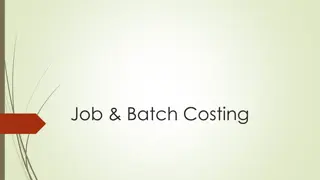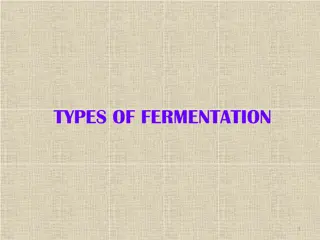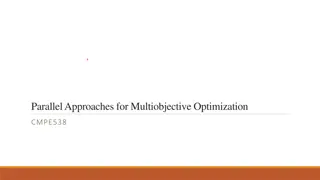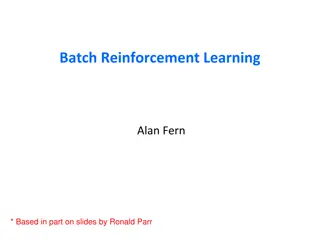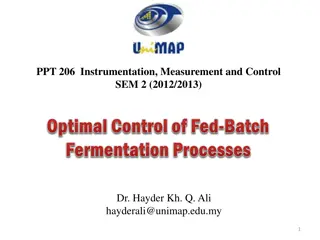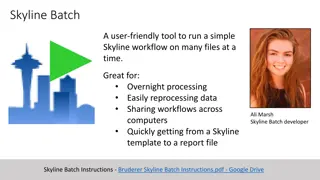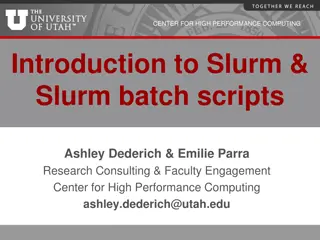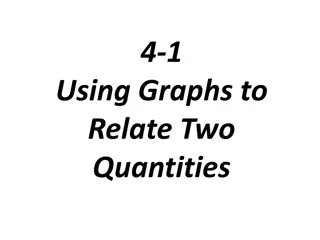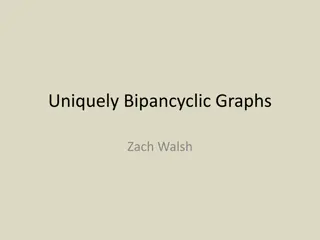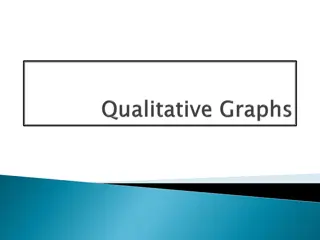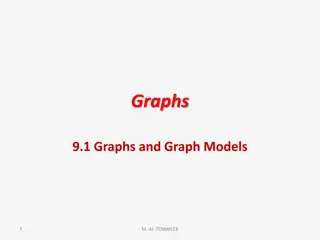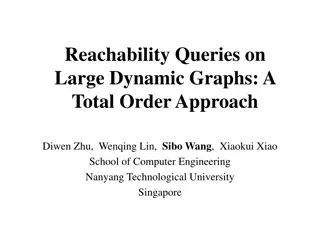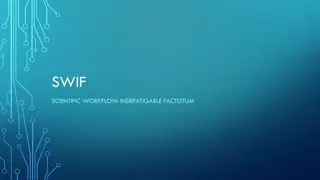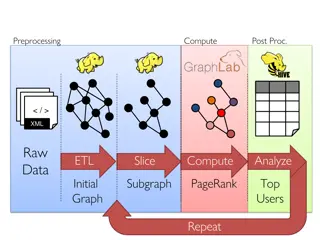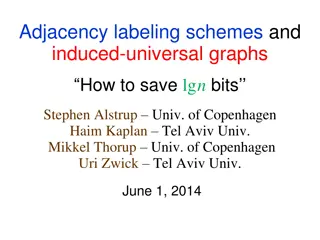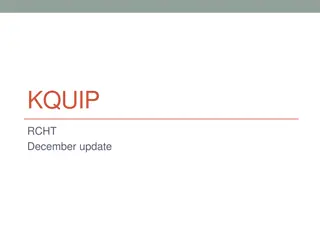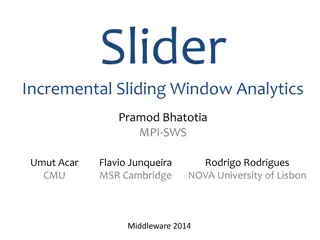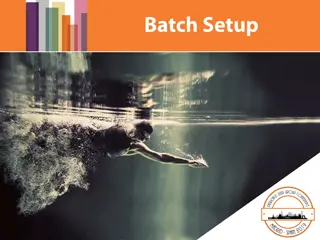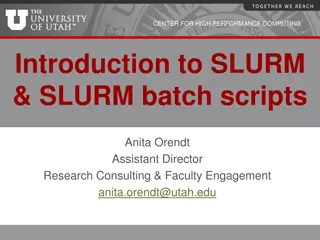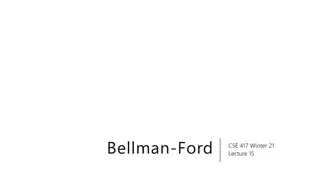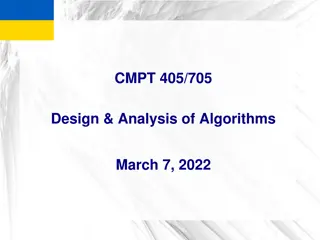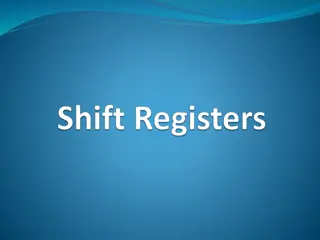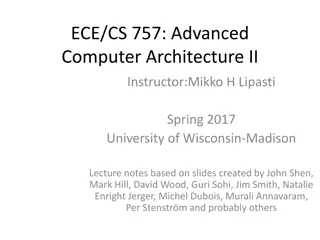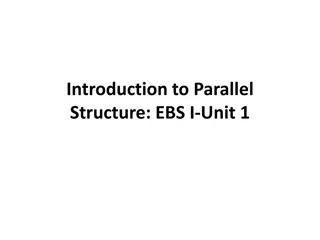Efficient Parallel Triangle Listing on Batch-Dynamic Graphs
Efficiently listing triangles in dynamic graphs is essential for identifying dense subgraphs in social networks. This study focuses on fast triangle listing in large graphs, particularly after batch updates, to find new and deleted triangles. The problem statement involves listing all triangles from the original graph and those inserted or deleted after an update. The influenced graph is considered to identify every triangle affected by a batch update, along with their neighborhood. The orientation technique and a naive solution are discussed, highlighting the challenges of parallel processing in triangle listing.
Download Presentation

Please find below an Image/Link to download the presentation.
The content on the website is provided AS IS for your information and personal use only. It may not be sold, licensed, or shared on other websites without obtaining consent from the author. Download presentation by click this link. If you encounter any issues during the download, it is possible that the publisher has removed the file from their server.
E N D
Presentation Transcript
DPTL+: Efficient Parallel Triangle Listing on Batch-Dynamic Graphs Michael Yu1, Lu Qin2, Ying Zhang2, Wenjie Zhang1, Xuemin Lin1 1University of New South Wales 2University of Technology Sydney
The Motivation There are many big social networks in which network communities exist as dense subgraphs. Find community for user-given query node(s). Enumerate or list all structures which are a user-given condition. (e.g., k-core, k-truss, subgraph) A triangle is a smallest dense subgraph with three vertices. Subgraphs with more triangles are considered dense. This motives us to study fast triangle listing which is to list all triangles in a big graph.
Batch-Update Graph Consider a graph that evolves. An interesting problem is to list all new triangles or deleted triangles after a batch- update of edges is received. Three are 2 main types of edges in a graph ?. original edges (solid) updated edges ? (dashed) inserted edges ?+ deleted edges ?
The Problem Statement Given an undirected simple graph ? = (?,?), let ?and ? denote the set of all triangles in the original graph ?, and all the triangles in a graph ? after a batch-update is processed. We list all triangles from { ? ?} (new triangles inserted from update) and those from { ? ? } (triangles deleted from update). 4
Influenced Graph To list every triangle affected by a batch-update B, we should also consider the affected neighbourhood of each updated edge. Influenced graph: An induced subgraph of ? where the set of vertices is the endpoints of edges from a batch-update B and their neighbours in G. 5
The Orientation Technique: An Example Undirected Graph ? 14 vertices 21 edges
The Orientation Technique: An Example Oriented Graph ? Based on degree-order Directed edge ?,? if deg(?) < deg(?)
A Nave Solution Iterate through each update edge (?,?) and list all affected triangles found by checking the neighbourhood of the two endpoints. Advantage: When processed sequentially, each new triangle will output only once because an updated triangle outputs only when the last new edge arrives. Disadvantage: It is difficult to parallel. A parallel implementation will produce duplicate triangle solutions. The overhead of sorting and removing duplicates is a significant bottleneck that leads to a poor performance.
The AOT Algorithm Use a state-of-the-art main memory triangle listing algorithm AOT (dasfaa2020) against the influenced graph. When done so, we refer to the algorithm as AOT*. Advantage: parallel implementation is readily available and is efficient. Disadvantage: It encounters unaffected triangles from the original graph ? during the computation. It must compute the intersection for all edges in the influenced graph, which includes original edges that do not participate in the formation of any new/updated triangle solutions.
The Key Issues We need some techniques to achieve the following. List each updated triangle only once in parallel Only compute the intersection for updated edges in B exclusively. The existing algorithms, with the orientation techniques developed, can achieve the first but cannot do well for the second.
Only Compute for the Updated Edges AOT* uses the orientation technique. Lists triangle on the oriented graph There is only one type of edge (original) All triangles can be listed by iterating all edges and taking the intersection of just the out-neighbourhoods (since cyclic triangles are impossible) Solutions are complete, and non duplicating Following this orientation method, we have iterate through all edges. Including original edges as well as updated edges. If we only iterate update edges, we will miss some updated-triangle solutions.
Dynamic Triangles Processing (1) We define three triangle types that consider the combination of original and new edges: 1, 2, and 3, referring to updated triangles with one, two and three new edges, respectively. Each triangle solution must belong to exactly one of the three. Note that the pivot edge is always an updated edge. With the basic orientation technique, we list all triangles without duplicates in parallel.
Dynamic Triangles Processing (2) For each triangle in 1, we choose the starting vertex of the new edge and the new edge as the pivot vertex and pivot edge, respectively. 6 instances when (?,?) is the pivot edge, When pivot vertex is ?, (a) (c) When pivot vertex is y, (d) (f) Note: ?,? is always an updated edge.
Dynamic Triangles Processing (3) For each triangle in 2, we choose the vertex ?with two new edges as the pivot vertex. The edge ? ? or ? ? is used as pivot edge where y is the starting vertex of the original edge. This pattern in practice refers to 6 specific valid instances (a)-(e) for two new edge triangles when the pivot vertex is ?.
Dynamic Triangles Processing (4) For each triangle in 3, we choose the vertex ? with two out-going new edges as the pivot vertex. The edge ? ? is used as pivot edge where the vertex ? has one in-going edgeand one out-going edge. There are two specific instances for when ? is the pivot vertex.
DPTL We only need to iterate updated edges in B exclusively. The definitions make it possible to execute in parallel by processing different pivot edges per thread There are 3 patterns that in total cover 42 cases for Pivot Edge and Pivot Vertex Assignment. We can list all triangles by listing all the triangle cases in each pivot vertex. DPTL solves the two issues and achieves a satisfactory solution for listing updated triangle.
Hashed-based Intersections DPTL is not efficient enough. DPTL uses merge-sort to perform every set-intersection, which is a time complexity of (max(deg(u), deg(v))) per edge This is the same as the Na ve method Hashing methods exist for calculating intersection computation. Building a hash-table for each updated edge is not affordable Better to build a hash-table once per pivot vertex u, and process all pivot edges ? ? since, by using orientation technique, we already ensured that deg(?) deg(?) for each edge ? ?. In theory, we want to achieve (min(deg(u); deg(v))) hash based intersection
DTPL: Cannot Use Hashing (1) In theory, achievable if we only use edge ? ? as the pivot edge for pivot vertex ?, and edge ? ? as pivot edge for pivot vertex ?. Case 2 does not ensure that deg(?) deg ? for every pivot edge (?,?) given pivot vertex ?. By definition, vertex ? is always the pivot vertex. We may use the edge ? ? as a pivot edge when ? is pivot vertex ( where u is by our orientation the lesser degree vertex ) If so, the hash will be initialized to ?, which needs more lookups for intersection
DTPL: Cannot Use Hashing (2) Case 1 ensures that deg(?) deg(?) is always true for pivot vertex u, and pivot edge ?,? . The specific instances covered by Case 1, all have the pivot edge assigned to the pivot vertex with the larger degree (as indicated by the orientation) Lookup cost will be minimum Case 1 definition does not need to be changed
DTPL: Cannot Use Hashing (3) Case 3 also ensures that deg(?) deg(?) is always true for pivot vertex u, and pivot edge ?,? . The specific instances covered by Case 3 all have pivot edges assigned together the pivot vertex is the larger degree (as indicated by the orientation). Lookup cost will be minimum Case 3 definition does not need to be changed
DPTL+ We re-design the process strategy for DPTL, by further considering Case 2 in two scenarios Case 2.1: choose vertex ? as the pivot vertex and ? ? as the pivot edge Case 2.2: chose vertex ? as the pivot vertex In DPTL+, hash table construct and initialize for each pivot vertex once and only once.
The Experiments 28 real-world graphs Baseline as comparator: Naive and AOT* Our Algorithms: DPTL and DPTL+ Default batch size (4%) and number of threads (8).
Results DPTL+ algorithm performs consistently better than the three methods tested. Compared with base design DPTL, addition of the hash- based technique does show an improvement.
Results Batch Size Given a fixed 8-threaded execution, we measure the performance given batch sizes set between 0.01% to 8% of the graph being processed. DPTL+ consistently outperforms other competitors under all settings. Note: Where the update-batch size increases, the increase in edge counts of the influenced graph increases at a significantly lower rate.
Result Parallel Capacity Threads between 1 to 32 threads. (Naive is not plotted because running-time exceeds an hour.) The efficiency of DPTL+ remains significantly faster in comparison For twitter-2010 and sk-2005, AOT* is faster than DPTL.
Conclusion (1) First systematic work for triangle listing on a batch-dynamic graph setting (2) Designed a new parallel triangle listing algorithm for batch-dynamic graphs (3) Improved our initial algorithm to consider the degree distribution of triangle pivot edges, and bound the computation with a good time complexity
End This is the end of the presentation. Thank you.




